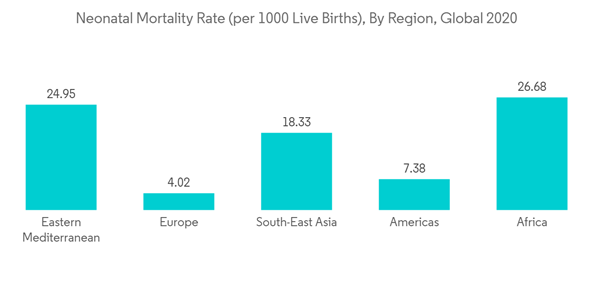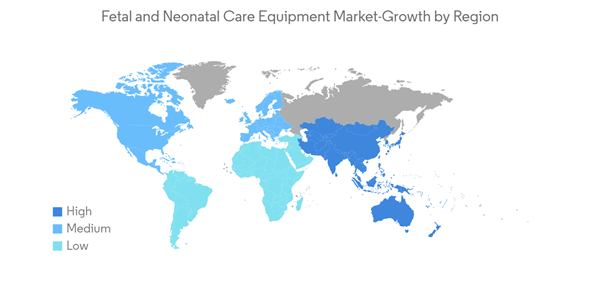The Global Fetal and Neonatal Care Equipment Market size is estimated at USD 7.84 billion in 2024, and is expected to reach USD 10.78 billion by 2029, growing at a CAGR of 6.57% during the forecast period (2024-2029).
The COVID-19 pandemic has significantly impacted the fetal and neonatal care equipment market. According to an October 2020 single-center study with the title, 'The effect of the COVID-19 pandemic on maternal health due to delay in seeking health care: Experience from a tertiary center', published in the International Journal of Gynecology and Obstetrics, inadequate prenatal visits were observed in one-third of the women. Lockdown and fear of infection were the top reasons for delayed health-seeking, resulting in 44.7% of pregnancies with problems. Also, according to a July 2020 report published in the Gynecologic and Obstetric Investigation, infection with COVID-19 during pregnancy increases the risk of pregnancy problems such as preterm birth, preterm premature rupture of the membranes, and, in rare circumstances, maternal mortality. As a result, vigilance should be exercised in further investigating and monitoring possible infection in neonates born to COVID-19-infected mothers, as well as providing appropriate care to both the mother and the baby. Thus, the market is predicted to rise due to the increased need for care.
The market growth can be largely attributed to factors such as the increasing number of preterm and low-weight births, growing technological advancement in infant and maternal care products, and rising congenital and pregnancy complications due to a sedentary lifestyle.
The rise in preterm and low-weight births is one of the major factors for the growth of the fetal and neonatal care equipment market. With the rising number of births, many complications are associated with preterm births, leading to neonatal deaths. Preterm birth is defined as a baby born alive before the 37th week of pregnancy, and birth weight of less than 2500 g is considered a low-weight birth. According to a July 2020 study published in the International Journal of Gynecology & Obstetrics with the title, 'Global burden of preterm birth,' there are around 15 million babies born prematurely around the world, resulting in a global preterm birth rate of about 11%. Additionally, in the United States, as per the Centers for Disease Control and Prevention, an article titled 'Preterm Birth,' updated in November 2021, reported that in 2020, one in every ten infants born were premature. Moreover, the incidence of diseases among newborns has also increased. These factors have increased the market demand for fetal and neonatal care equipment.
In addition, rising key market initiatives by the market players are also expected to drive market growth due to the rise in adoption. For instance, in May 2020, Dragerwerk AG & Co. KGaA launched the Evita V600 and V800, as well as the Babylog VN600 and VN800, devices for acute care ventilation of adults and preterm babies, and the devices were made available for purchase all over the world.
However, the stringent regulatory policies for new device approvals and high prices of advanced neonatal care equipment are the major factors hindering growth in fetal and neonatal care equipment.
The factors contributing to the segment's growth are the rising need for fetal care and product launches. As per the Centers for Disease Control and Prevention (CDC) update in August 2021, in the United States, about 2% to 10% of pregnancies are affected by gestational diabetes. Thus, for the management of gestational diabetes, the demand for fetal care equipment is increasing.
Several companies are engaged in approvals and product launches. For instance, in August 2020, Pulsenmore Ltd., an Israeli firm involved in the manufacturing and marketing ultrasound devices, launched the tele-ultrasound device. This first-ever self-administered ultrasound device enables pregnant women to perform at-home ultrasound scans.
Thus, considering the abovementioned factors, the market is anticipated to grow significantly over the forecast period.
Moreover, the presence of major key players operating in the industry is boosting the growth of the neonatal and fetal care equipment market over the forecast period. The presence of prominent players results in more product approvals and developments. For Instance, in June 2021, Nuvo Group received the United States Food and Drug Administration approval for the expanded utility of its INVU, a prescription-initiated remote pregnancy monitoring platform to add a new module that enables remote monitoring of uterine activity.
Furthermore, a surge in the number of neonatal fetal deaths in Canada will likely supplement the market growth over the analysis period. For instance, as per data published by the World Health Organization, updated in 2022, the neonatal mortality rate is 3.18 per 1000 live births in Canada and 3.38 per 1000 live births in the United States of America in 2020. Such a high burden of deaths creates the need for neonatal care equipment in the region and is thus expected to drive the growth of the market.
Thus, given the abovementioned factors, the market is expected to witness significant regional growth over the forecast period.
This product will be delivered within 2 business days.
The COVID-19 pandemic has significantly impacted the fetal and neonatal care equipment market. According to an October 2020 single-center study with the title, 'The effect of the COVID-19 pandemic on maternal health due to delay in seeking health care: Experience from a tertiary center', published in the International Journal of Gynecology and Obstetrics, inadequate prenatal visits were observed in one-third of the women. Lockdown and fear of infection were the top reasons for delayed health-seeking, resulting in 44.7% of pregnancies with problems. Also, according to a July 2020 report published in the Gynecologic and Obstetric Investigation, infection with COVID-19 during pregnancy increases the risk of pregnancy problems such as preterm birth, preterm premature rupture of the membranes, and, in rare circumstances, maternal mortality. As a result, vigilance should be exercised in further investigating and monitoring possible infection in neonates born to COVID-19-infected mothers, as well as providing appropriate care to both the mother and the baby. Thus, the market is predicted to rise due to the increased need for care.
The market growth can be largely attributed to factors such as the increasing number of preterm and low-weight births, growing technological advancement in infant and maternal care products, and rising congenital and pregnancy complications due to a sedentary lifestyle.
The rise in preterm and low-weight births is one of the major factors for the growth of the fetal and neonatal care equipment market. With the rising number of births, many complications are associated with preterm births, leading to neonatal deaths. Preterm birth is defined as a baby born alive before the 37th week of pregnancy, and birth weight of less than 2500 g is considered a low-weight birth. According to a July 2020 study published in the International Journal of Gynecology & Obstetrics with the title, 'Global burden of preterm birth,' there are around 15 million babies born prematurely around the world, resulting in a global preterm birth rate of about 11%. Additionally, in the United States, as per the Centers for Disease Control and Prevention, an article titled 'Preterm Birth,' updated in November 2021, reported that in 2020, one in every ten infants born were premature. Moreover, the incidence of diseases among newborns has also increased. These factors have increased the market demand for fetal and neonatal care equipment.
In addition, rising key market initiatives by the market players are also expected to drive market growth due to the rise in adoption. For instance, in May 2020, Dragerwerk AG & Co. KGaA launched the Evita V600 and V800, as well as the Babylog VN600 and VN800, devices for acute care ventilation of adults and preterm babies, and the devices were made available for purchase all over the world.
However, the stringent regulatory policies for new device approvals and high prices of advanced neonatal care equipment are the major factors hindering growth in fetal and neonatal care equipment.
Fetal and Neonatal Care Equipment Market Trends
Fetal Care Equipment is Expected to Project Significant Market Growth Over the Forecast Period
Based on the product, fetal care equipment is anticipated to witness significant growth. Fetal care equipment is required for monitoring and care of the fetus. Several fetal care equipment is used, such as fetal dopplers, fetal pulse oximeters, and fetal magnetic resonance imaging(MRI) devices.The factors contributing to the segment's growth are the rising need for fetal care and product launches. As per the Centers for Disease Control and Prevention (CDC) update in August 2021, in the United States, about 2% to 10% of pregnancies are affected by gestational diabetes. Thus, for the management of gestational diabetes, the demand for fetal care equipment is increasing.
Several companies are engaged in approvals and product launches. For instance, in August 2020, Pulsenmore Ltd., an Israeli firm involved in the manufacturing and marketing ultrasound devices, launched the tele-ultrasound device. This first-ever self-administered ultrasound device enables pregnant women to perform at-home ultrasound scans.
Thus, considering the abovementioned factors, the market is anticipated to grow significantly over the forecast period.
North America Holds Major Share in the Market and Expected To Do Over the Forecast Period
North America is expected to hold a major share in the fetal and neonatal care equipment market and will continue over the forecast period. This can be attributed to the presence of well-established healthcare facilities and the rise in the demand for advanced healthcare systems. In the United States, the value-based healthcare model has led to the development of highly specialized NICU centers, with the rise in the number of devices from the United States Food and Drug Administration (USFDA).Moreover, the presence of major key players operating in the industry is boosting the growth of the neonatal and fetal care equipment market over the forecast period. The presence of prominent players results in more product approvals and developments. For Instance, in June 2021, Nuvo Group received the United States Food and Drug Administration approval for the expanded utility of its INVU, a prescription-initiated remote pregnancy monitoring platform to add a new module that enables remote monitoring of uterine activity.
Furthermore, a surge in the number of neonatal fetal deaths in Canada will likely supplement the market growth over the analysis period. For instance, as per data published by the World Health Organization, updated in 2022, the neonatal mortality rate is 3.18 per 1000 live births in Canada and 3.38 per 1000 live births in the United States of America in 2020. Such a high burden of deaths creates the need for neonatal care equipment in the region and is thus expected to drive the growth of the market.
Thus, given the abovementioned factors, the market is expected to witness significant regional growth over the forecast period.
Fetal and Neonatal Care Equipment Industry Overview
The global fetal and neonatal care equipment market consists of a few major players holding the major shares of the market. The market is expected to drive due to the rise in fetal and neonatal deaths and rising strategies by the key market players, among others. Some key market players include Atom Medical Corporation, Becton, Dickinson and Company, Dragerwerk AG & Co. KGaA, GE Healthcare, Koninklijke Philips NV, Masimo, Medtronic PLC, Natus Medical Incorporated, Phoenix Medical Systems (P) Ltd, and Vyaire Medical, among others.Additional Benefits:
- The market estimate (ME) sheet in Excel format
- 3 months of analyst support
This product will be delivered within 2 business days.
Table of Contents
1 INTRODUCTION
4 MARKET DYNAMICS
5 MARKET SEGMENTATION (Market Size by Value - USD million)
6 COMPETITIVE LANDSCAPE
Companies Mentioned (Partial List)
A selection of companies mentioned in this report includes, but is not limited to:
- Atom Medical Corporation
- Becton, Dickinson and Company
- Dragerwerk AG & Co. KGaA
- GE Healthcare
- Koninklijke Philips NV
- Masimo
- Medtronic PLC
- Natus Medical Incorporated
- Phoenix Medical Systems (P) Ltd
- Vyaire Medical
- Huntleigh Healthcare Limited
- Fisher & Paykel Healthcare Limited.
- Utah Medical Products
Methodology

LOADING...










